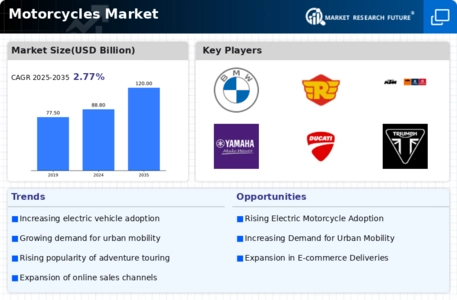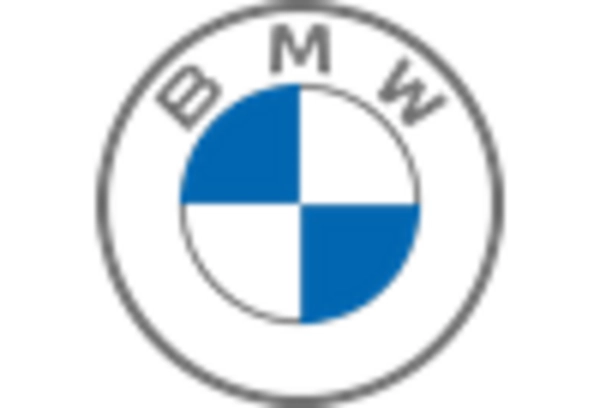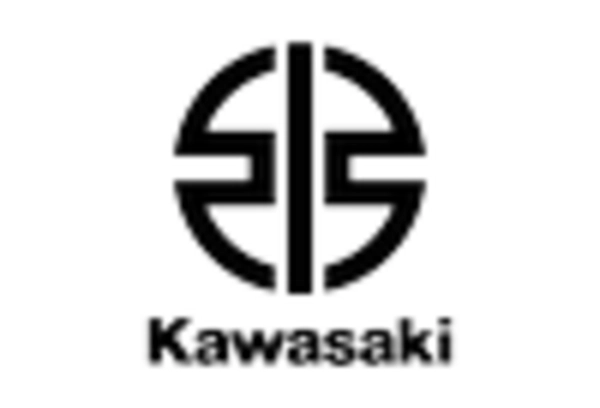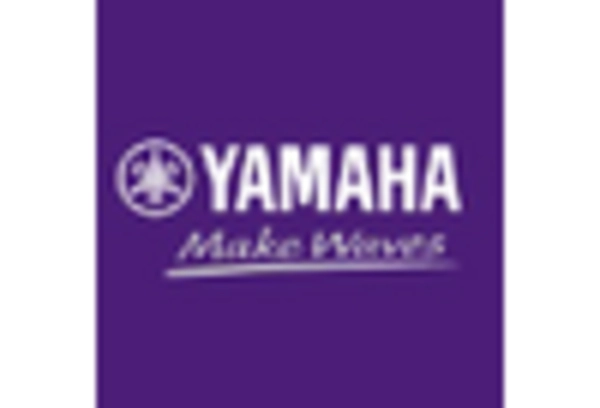Cruiser
Sport
Touring
Standard
Dirt
Internal Combustion Engine
Electric Motor
Hybrid Engine
Personal Use
Commercial Use
Sports Use
Online
Offline
Dealerships
North America
Europe
South America
Asia Pacific
Middle East and Africa
North America Outlook (USD Billion, 2019-2035)
North America Motorcycles Market by Motorcycle Type
Cruiser
Sport
Touring
Standard
Dirt
North America Motorcycles Market by Engine Type
Internal Combustion Engine
Electric Motor
Hybrid Engine
North America Motorcycles Market by End Use Type
Personal Use
Commercial Use
Sports Use
North America Motorcycles Market by Distribution Channel Type
Online
Offline
Dealerships
North America Motorcycles Market by Regional Type
US
Canada
US Outlook (USD Billion, 2019-2035)
US Motorcycles Market by Motorcycle Type
Cruiser
Sport
Touring
Standard
Dirt
US Motorcycles Market by Engine Type
Internal Combustion Engine
Electric Motor
Hybrid Engine
US Motorcycles Market by End Use Type
Personal Use
Commercial Use
Sports Use
US Motorcycles Market by Distribution Channel Type
Online
Offline
Dealerships
CANADA Outlook (USD Billion, 2019-2035)
CANADA Motorcycles Market by Motorcycle Type
Cruiser
Sport
Touring
Standard
Dirt
CANADA Motorcycles Market by Engine Type
Internal Combustion Engine
Electric Motor
Hybrid Engine
CANADA Motorcycles Market by End Use Type
Personal Use
Commercial Use
Sports Use
CANADA Motorcycles Market by Distribution Channel Type
Online
Offline
Dealerships
Europe Outlook (USD Billion, 2019-2035)
Europe Motorcycles Market by Motorcycle Type
Cruiser
Sport
Touring
Standard
Dirt
Europe Motorcycles Market by Engine Type
Internal Combustion Engine
Electric Motor
Hybrid Engine
Europe Motorcycles Market by End Use Type
Personal Use
Commercial Use
Sports Use
Europe Motorcycles Market by Distribution Channel Type
Online
Offline
Dealerships
Europe Motorcycles Market by Regional Type
Germany
UK
France
Russia
Italy
Spain
Rest of Europe
GERMANY Outlook (USD Billion, 2019-2035)
GERMANY Motorcycles Market by Motorcycle Type
Cruiser
Sport
Touring
Standard
Dirt
GERMANY Motorcycles Market by Engine Type
Internal Combustion Engine
Electric Motor
Hybrid Engine
GERMANY Motorcycles Market by End Use Type
Personal Use
Commercial Use
Sports Use
GERMANY Motorcycles Market by Distribution Channel Type
Online
Offline
Dealerships
UK Outlook (USD Billion, 2019-2035)
UK Motorcycles Market by Motorcycle Type
Cruiser
Sport
Touring
Standard
Dirt
UK Motorcycles Market by Engine Type
Internal Combustion Engine
Electric Motor
Hybrid Engine
UK Motorcycles Market by End Use Type
Personal Use
Commercial Use
Sports Use
UK Motorcycles Market by Distribution Channel Type
Online
Offline
Dealerships
FRANCE Outlook (USD Billion, 2019-2035)
FRANCE Motorcycles Market by Motorcycle Type
Cruiser
Sport
Touring
Standard
Dirt
FRANCE Motorcycles Market by Engine Type
Internal Combustion Engine
Electric Motor
Hybrid Engine
FRANCE Motorcycles Market by End Use Type
Personal Use
Commercial Use
Sports Use
FRANCE Motorcycles Market by Distribution Channel Type
Online
Offline
Dealerships
RUSSIA Outlook (USD Billion, 2019-2035)
RUSSIA Motorcycles Market by Motorcycle Type
Cruiser
Sport
Touring
Standard
Dirt
RUSSIA Motorcycles Market by Engine Type
Internal Combustion Engine
Electric Motor
Hybrid Engine
RUSSIA Motorcycles Market by End Use Type
Personal Use
Commercial Use
Sports Use
RUSSIA Motorcycles Market by Distribution Channel Type
Online
Offline
Dealerships
ITALY Outlook (USD Billion, 2019-2035)
ITALY Motorcycles Market by Motorcycle Type
Cruiser
Sport
Touring
Standard
Dirt
ITALY Motorcycles Market by Engine Type
Internal Combustion Engine
Electric Motor
Hybrid Engine
ITALY Motorcycles Market by End Use Type
Personal Use
Commercial Use
Sports Use
ITALY Motorcycles Market by Distribution Channel Type
Online
Offline
Dealerships
SPAIN Outlook (USD Billion, 2019-2035)
SPAIN Motorcycles Market by Motorcycle Type
Cruiser
Sport
Touring
Standard
Dirt
SPAIN Motorcycles Market by Engine Type
Internal Combustion Engine
Electric Motor
Hybrid Engine
SPAIN Motorcycles Market by End Use Type
Personal Use
Commercial Use
Sports Use
SPAIN Motorcycles Market by Distribution Channel Type
Online
Offline
Dealerships
REST OF EUROPE Outlook (USD Billion, 2019-2035)
REST OF EUROPE Motorcycles Market by Motorcycle Type
Cruiser
Sport
Touring
Standard
Dirt
REST OF EUROPE Motorcycles Market by Engine Type
Internal Combustion Engine
Electric Motor
Hybrid Engine
REST OF EUROPE Motorcycles Market by End Use Type
Personal Use
Commercial Use
Sports Use
REST OF EUROPE Motorcycles Market by Distribution Channel Type
Online
Offline
Dealerships
APAC Outlook (USD Billion, 2019-2035)
APAC Motorcycles Market by Motorcycle Type
Cruiser
Sport
Touring
Standard
Dirt
APAC Motorcycles Market by Engine Type
Internal Combustion Engine
Electric Motor
Hybrid Engine
APAC Motorcycles Market by End Use Type
Personal Use
Commercial Use
Sports Use
APAC Motorcycles Market by Distribution Channel Type
Online
Offline
Dealerships
APAC Motorcycles Market by Regional Type
China
India
Japan
South Korea
Malaysia
Thailand
Indonesia
Rest of APAC
CHINA Outlook (USD Billion, 2019-2035)
CHINA Motorcycles Market by Motorcycle Type
Cruiser
Sport
Touring
Standard
Dirt
CHINA Motorcycles Market by Engine Type
Internal Combustion Engine
Electric Motor
Hybrid Engine
CHINA Motorcycles Market by End Use Type
Personal Use
Commercial Use
Sports Use
CHINA Motorcycles Market by Distribution Channel Type
Online
Offline
Dealerships
INDIA Outlook (USD Billion, 2019-2035)
INDIA Motorcycles Market by Motorcycle Type
Cruiser
Sport
Touring
Standard
Dirt
INDIA Motorcycles Market by Engine Type
Internal Combustion Engine
Electric Motor
Hybrid Engine
INDIA Motorcycles Market by End Use Type
Personal Use
Commercial Use
Sports Use
INDIA Motorcycles Market by Distribution Channel Type
Online
Offline
Dealerships
JAPAN Outlook (USD Billion, 2019-2035)
JAPAN Motorcycles Market by Motorcycle Type
Cruiser
Sport
Touring
Standard
Dirt
JAPAN Motorcycles Market by Engine Type
Internal Combustion Engine
Electric Motor
Hybrid Engine
JAPAN Motorcycles Market by End Use Type
Personal Use
Commercial Use
Sports Use
JAPAN Motorcycles Market by Distribution Channel Type
Online
Offline
Dealerships
SOUTH KOREA Outlook (USD Billion, 2019-2035)
SOUTH KOREA Motorcycles Market by Motorcycle Type
Cruiser
Sport
Touring
Standard
Dirt
SOUTH KOREA Motorcycles Market by Engine Type
Internal Combustion Engine
Electric Motor
Hybrid Engine
SOUTH KOREA Motorcycles Market by End Use Type
Personal Use
Commercial Use
Sports Use
SOUTH KOREA Motorcycles Market by Distribution Channel Type
Online
Offline
Dealerships
MALAYSIA Outlook (USD Billion, 2019-2035)
MALAYSIA Motorcycles Market by Motorcycle Type
Cruiser
Sport
Touring
Standard
Dirt
MALAYSIA Motorcycles Market by Engine Type
Internal Combustion Engine
Electric Motor
Hybrid Engine
MALAYSIA Motorcycles Market by End Use Type
Personal Use
Commercial Use
Sports Use
MALAYSIA Motorcycles Market by Distribution Channel Type
Online
Offline
Dealerships
THAILAND Outlook (USD Billion, 2019-2035)
THAILAND Motorcycles Market by Motorcycle Type
Cruiser
Sport
Touring
Standard
Dirt
THAILAND Motorcycles Market by Engine Type
Internal Combustion Engine
Electric Motor
Hybrid Engine
THAILAND Motorcycles Market by End Use Type
Personal Use
Commercial Use
Sports Use
THAILAND Motorcycles Market by Distribution Channel Type
Online
Offline
Dealerships
INDONESIA Outlook (USD Billion, 2019-2035)
INDONESIA Motorcycles Market by Motorcycle Type
Cruiser
Sport
Touring
Standard
Dirt
INDONESIA Motorcycles Market by Engine Type
Internal Combustion Engine
Electric Motor
Hybrid Engine
INDONESIA Motorcycles Market by End Use Type
Personal Use
Commercial Use
Sports Use
INDONESIA Motorcycles Market by Distribution Channel Type
Online
Offline
Dealerships
REST OF APAC Outlook (USD Billion, 2019-2035)
REST OF APAC Motorcycles Market by Motorcycle Type
Cruiser
Sport
Touring
Standard
Dirt
REST OF APAC Motorcycles Market by Engine Type
Internal Combustion Engine
Electric Motor
Hybrid Engine
REST OF APAC Motorcycles Market by End Use Type
Personal Use
Commercial Use
Sports Use
REST OF APAC Motorcycles Market by Distribution Channel Type
Online
Offline
Dealerships
South America Outlook (USD Billion, 2019-2035)
South America Motorcycles Market by Motorcycle Type
Cruiser
Sport
Touring
Standard
Dirt
South America Motorcycles Market by Engine Type
Internal Combustion Engine
Electric Motor
Hybrid Engine
South America Motorcycles Market by End Use Type
Personal Use
Commercial Use
Sports Use
South America Motorcycles Market by Distribution Channel Type
Online
Offline
Dealerships
South America Motorcycles Market by Regional Type
Brazil
Mexico
Argentina
Rest of South America
BRAZIL Outlook (USD Billion, 2019-2035)
BRAZIL Motorcycles Market by Motorcycle Type
Cruiser
Sport
Touring
Standard
Dirt
BRAZIL Motorcycles Market by Engine Type
Internal Combustion Engine
Electric Motor
Hybrid Engine
BRAZIL Motorcycles Market by End Use Type
Personal Use
Commercial Use
Sports Use
BRAZIL Motorcycles Market by Distribution Channel Type
Online
Offline
Dealerships
MEXICO Outlook (USD Billion, 2019-2035)
MEXICO Motorcycles Market by Motorcycle Type
Cruiser
Sport
Touring
Standard
Dirt
MEXICO Motorcycles Market by Engine Type
Internal Combustion Engine
Electric Motor
Hybrid Engine
MEXICO Motorcycles Market by End Use Type
Personal Use
Commercial Use
Sports Use
MEXICO Motorcycles Market by Distribution Channel Type
Online
Offline
Dealerships
ARGENTINA Outlook (USD Billion, 2019-2035)
ARGENTINA Motorcycles Market by Motorcycle Type
Cruiser
Sport
Touring
Standard
Dirt
ARGENTINA Motorcycles Market by Engine Type
Internal Combustion Engine
Electric Motor
Hybrid Engine
ARGENTINA Motorcycles Market by End Use Type
Personal Use
Commercial Use
Sports Use
ARGENTINA Motorcycles Market by Distribution Channel Type
Online
Offline
Dealerships
REST OF SOUTH AMERICA Outlook (USD Billion, 2019-2035)
REST OF SOUTH AMERICA Motorcycles Market by Motorcycle Type
Cruiser
Sport
Touring
Standard
Dirt
REST OF SOUTH AMERICA Motorcycles Market by Engine Type
Internal Combustion Engine
Electric Motor
Hybrid Engine
REST OF SOUTH AMERICA Motorcycles Market by End Use Type
Personal Use
Commercial Use
Sports Use
REST OF SOUTH AMERICA Motorcycles Market by Distribution Channel Type
Online
Offline
Dealerships
MEA Outlook (USD Billion, 2019-2035)
MEA Motorcycles Market by Motorcycle Type
Cruiser
Sport
Touring
Standard
Dirt
MEA Motorcycles Market by Engine Type
Internal Combustion Engine
Electric Motor
Hybrid Engine
MEA Motorcycles Market by End Use Type
Personal Use
Commercial Use
Sports Use
MEA Motorcycles Market by Distribution Channel Type
Online
Offline
Dealerships
MEA Motorcycles Market by Regional Type
GCC Countries
South Africa
Rest of MEA
GCC COUNTRIES Outlook (USD Billion, 2019-2035)
GCC COUNTRIES Motorcycles Market by Motorcycle Type
Cruiser
Sport
Touring
Standard
Dirt
GCC COUNTRIES Motorcycles Market by Engine Type
Internal Combustion Engine
Electric Motor
Hybrid Engine
GCC COUNTRIES Motorcycles Market by End Use Type
Personal Use
Commercial Use
Sports Use
GCC COUNTRIES Motorcycles Market by Distribution Channel Type
Online
Offline
Dealerships
SOUTH AFRICA Outlook (USD Billion, 2019-2035)
SOUTH AFRICA Motorcycles Market by Motorcycle Type
Cruiser
Sport
Touring
Standard
Dirt
SOUTH AFRICA Motorcycles Market by Engine Type
Internal Combustion Engine
Electric Motor
Hybrid Engine
SOUTH AFRICA Motorcycles Market by End Use Type
Personal Use
Commercial Use
Sports Use
SOUTH AFRICA Motorcycles Market by Distribution Channel Type
Online
Offline
Dealerships
REST OF MEA Outlook (USD Billion, 2019-2035)
REST OF MEA Motorcycles Market by Motorcycle Type
Cruiser
Sport
Touring
Standard
Dirt
REST OF MEA Motorcycles Market by Engine Type
Internal Combustion Engine
Electric Motor
Hybrid Engine
REST OF MEA Motorcycles Market by End Use Type
Personal Use
Commercial Use
Sports Use
REST OF MEA Motorcycles Market by Distribution Channel Type
Online
Offline
Dealerships









Leave a Comment